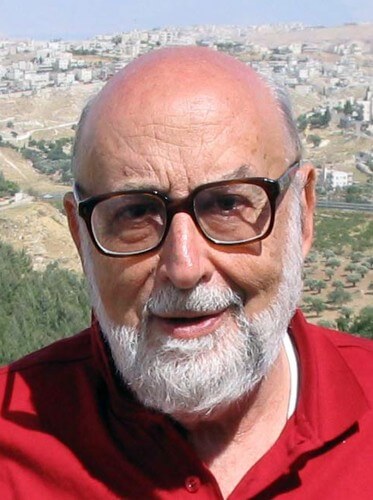Prof. Engler is a Sackler Fellow - Senior Professor with special status at Tel Aviv University's School of Physics. During his visit to Tel Aviv University in April of this year, Prof. Engler gave a special lecture to students and faculty members in physics. In this lecture he referred to the work which has now earned him the Nobel Prize in Physics

see also:
Prof. Francois Engler won today jointly with Prof. Peter Higgs, the Nobel Prize in Physics in recognition of his work which explains how the elementary particles in nature and the calibration particles that carry the weak force get their mass. The mechanism that was deduced allows us, within the standard model of the world of elementary particles, to "unify" the weak force and the electromagnetic force. It forms the theoretical basis for the dramatic discovery of the new particle (Higgs particle) in the giant accelerator LHC at the CERN laboratory in Geneva.
Prof. Engler is a Belgian Jew, professor emeritus at the University of Brussels and has the closest research ties with Tel Aviv University for about thirty years. Professor Engler has been appointed at Tel Aviv University as a Sackler Fellow - a senior professor with special status in the School of Physics. This is within the framework of the Sackler program in which the university gives a special prestigious appointment to leading researchers and experts in the world who come for frequent visits and create research relationships and joint work with the university's researchers. In April of this year, during his visit to the university, he gave a special lecture to students and faculty members in physics. In this lecture, he referred to the work that has now earned him the Nobel Prize for Physics, and previously the Wolf Prize for Physics for 2004, and the Scourai Prize in 2010, together with two other scientists, the late Robert Braut and Peter Higgs, who has now won the Nobel Prize together with him.
The impressive developments in physics in the first third of the last century first gave a basis for the hope that all phenomena in nature, from the structure of atoms to the structure of the universe, can be explained by the two fundamental forces that were known at the time - gravity and the electric force.
These forces are described by Einstein's theory of gravity and quantum electromagnetic theory. But these are long term powers. The discovery of subatomic structures made it clear to us that there are other fundamental forces that are short-lived. These forces are very weak at large distances, but are dominant at subatomic distances. They are responsible, among other things, for the energy production mechanism in the sun and other stars. Attempts to understand the short-term cause of these forces first encountered difficulties that seemed insurmountable, until Braut and Engler, and shortly after Higgs, proposed a radical solution. Their solution is based on the existence of a field that fills the universe and which, through its interaction with the other elementary particles, gives them mass and thereby turns long-term forces into short-term forces. This idea opens up new horizons for achieving Einstein's old dream - the unification of all the fundamental forces in nature. An immediate prediction arising from this idea is the existence of a particle associated with the quantum fluctuations of this constant field - the Higgs particle. The impressive discovery of the new particle at CERN provides direct confirmation of the theory and mechanism of mass creation and has implications for the possible structure of matter at much higher energies than those studied so far.
Chairman of the Israeli Committee for High Energies: Justice has been done
Prof. Eliezer Rabinovitch, from the Rakah Institute of Physics and former head of the Institute for Advanced Studies at the Hebrew University.
Prof. Rabinovitch is the chairman of the Israeli National Committee for High Energies and Israel's representative on the Ceran Council which recently proved the existence of the Higgs particle, and a colleague of Prof. Francois Engler. Prof. Engler was a fellow at the Institute for Advanced Studies of the Hebrew University.
According to Prof. Rabinovich, "Justice has been done. Higgs and Engler were supposed to receive the Nobel Prize years ago for the discovery of the divine particle, but for various reasons the prize committee decided to ignore them and their important discovery. Now that the experiments with the particle accelerator in the axle have proven that they were right all along, the prize committee has corrected the distortion."

3 תגובות
It is not clear what Professor Rabinovitch is complaining about.
Nobel prizes for theory are awarded, as far as I know, only after the theory is confirmed by experiment. not before.
Correction of web page address:
http://ofer-megged.blogspot.co.il/2012/07/blog-post.html
I wrote about the amusing tension between Higgs and Englert following the development of the Higgs mechanism a year ago in a list that contained a rolling report from CERN. Those interested will find it here:
http://ofer-megged-phys-notes.blogspot.co.il/2013/09/blog-post_26.html